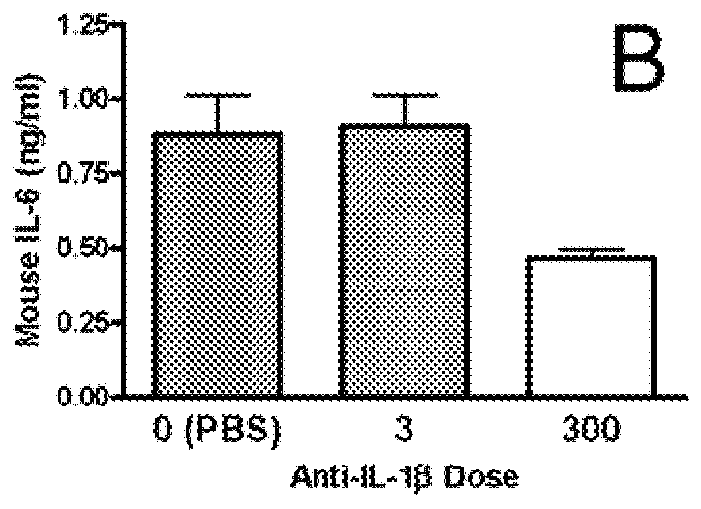Methods for improvement of beta cell function with anti-IL-1β antibodies or fragments thereof
a beta cell and anti-il-1 technology, applied in the field of methods for improving can solve the problems of hyperglycemia (abnormally high level of glucose in the blood), severe, long-term and debilitating complications involving several organ systems, and improve the function of beta cells. , improve the glycemic control, and improve the effect of beta cell function
- Summary
- Abstract
- Description
- Claims
- Application Information
AI Technical Summary
Benefits of technology
Problems solved by technology
Method used
Image
Examples
example 1
Inhibition of IL-1β Using a High Affinity IL-1β Antibody in an In Vitro Cell Based Assay, With IL-1 Induced Production of IL-8 as a Read-Out
[0235]The inhibitory effect of an IL-1β-specific antibody was compared to a non-antibody inhibitor of the IL-1 pathway, Kineret® (anakinra), which is a recombinant IL-1 receptor antagonist. Fresh, heparinized peripheral blood was collected from healthy donors. 180 μl of whole blood was plated in a 96-well plate and incubated with various concentrations of the antibody AB7 (U.S. application Ser. No. 11 / 472,813, WO 2007 / 002261) and 100 μM rhIL-1β. For anakinra-treated samples, anakinra and rhIL-1β were combined 1:1 prior to mixing with blood. Samples were incubated for 6 hours at 37° C. with 5% CO2. Whole blood cells were then lysed with 50 μl 2.5% Triton X-100. The concentration of interleukin-8 (IL-8) in cleared lysates was assayed by ELISA (Quantikine human IL-8 ELISA kit, R&D Systems) according to manufacturer's instructions. IL-8 concentratio...
example 2
In Vivo Inhibition of the Biological Activity of Human IL-1β Using IL-1β-Specific Antibodies, as Measured by the Impact on IL-1β Stimulated Release of IL-6
[0238]To confirm the in vivo efficacy of AB7, its ability to block the biological activity of human IL-1β was tested in a murine model. Details of the assay are described in Economides et al., Nature Med., 9: 47-52 (2003). Briefly, male C57 / B16 mice (Jackson Laboratory Bar Harbor, Me.) were injected intraperitoneally with titrated doses of AB7, another IL-1β antibody, AB5, or a control antibody. Twenty-four hours after antibody injection, mice were injected subcutaneously with recombinant human IL-1β (rhIL-1β) (from PeproTech Inc., Rocky Hill, N.J.) at a dose of 1 μg / kg. Two hours post-rhIL-1β injection (peak IL-6 response time), mice were sacrificed, and blood was collected and processed for serum. Serum IL-6 levels were assayed by ELISA (BD Pharmingen, Franklin Lakes, N.J.) according to the manufacturer's protocol. Percent inhib...
example 3
Effect of Anti-IL-1β Antibodies in a Human Islet Cell Assay System
[0241]As an in vitro model, human islet cells are isolated and then treated with high glucose levels to mimic the Type 2 diabetic environment. Anti-IL-1β antibodies may be used in the islet cell system to examine the effect on beta cell function (insulin release in response to glucose), beta cell proliferation and apoptosis.
[0242]Islets are isolated from the pancreases of multiple human organ donors with no history of diabetes or metabolic disease as described (Linetsky et al., Diabetes 46:1120-1123, 1997; Oberholzer et al., Transplantation 69:1115-1123, 2000; Ricordi et al., Diabetes 37:413-420, 1988, Maedler et al., Proc. Natl. Acad. Sci. USA 101:8138-8143, 2004; WO 2004 / 0002512). The islets are then cultured on extracellular matrix-coated plates derived from bovine corneal endothelial cells (Novamed Ltd, Jerusalem), allowing the cells to attach to the plates and preserving their functional integrity. The islets are...
PUM
| Property | Measurement | Unit |
|---|---|---|
| dissociation constant | aaaaa | aaaaa |
| dissociation constant | aaaaa | aaaaa |
| dissociation constant | aaaaa | aaaaa |
Abstract
Description
Claims
Application Information
 Login to View More
Login to View More - R&D
- Intellectual Property
- Life Sciences
- Materials
- Tech Scout
- Unparalleled Data Quality
- Higher Quality Content
- 60% Fewer Hallucinations
Browse by: Latest US Patents, China's latest patents, Technical Efficacy Thesaurus, Application Domain, Technology Topic, Popular Technical Reports.
© 2025 PatSnap. All rights reserved.Legal|Privacy policy|Modern Slavery Act Transparency Statement|Sitemap|About US| Contact US: help@patsnap.com



